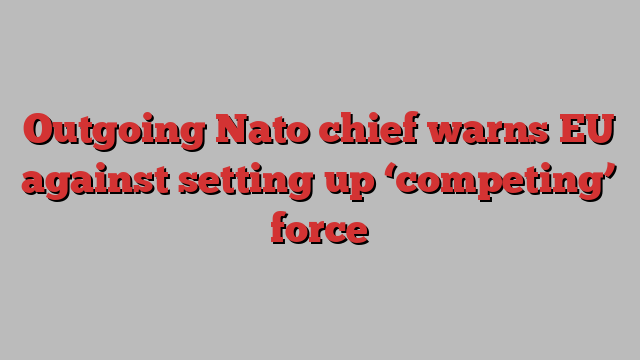
Unlock the Editor’s Digest for free
Roula Khalaf, Editor of the FT, selects her favourite stories in this weekly newsletter.
Nato’s outgoing secretary-general Jens Stoltenberg has warned against EU defence efforts duplicating or competing with the US-led military alliance, given scarce funding and personnel.
In unusually blunt remarks at a farewell event on Thursday hosted by the German Marshall Fund in Brussels, Stoltenberg said the EU’s ambition to create separate command structures and a planned rapid response force risked diverting resources from the US-led military alliance.
“I welcome more EU efforts on defence as long as they are done in a way that doesn’t duplicate or compete,” he said.
“What the EU should not do is start to build alternative defence structures, for instance the intervention force,” he said, in reference to the planned 5,000-strong troops the EU put forward in 2022 following Russia’s full-scale invasion of Ukraine.
“I don’t understand why there is a need for a different, competing intervention force,” Stoltenberg said.
Given that “we struggle a bit to man all the positions” in Nato’s command structure, he said “it would be a bit strange if the same countries were not able to send as many officers as they should to instead build an alternative structure”.
The EU’s defence efforts were already diverting resources from existing Nato structures, senior alliance officials told the Financial Times.
“If Europe is under attack, people need to know immediately who is in charge of responding to that,” said one of the alliance officials, who declined to be identified due to the sensitivity of the issue. “Competing structures create uncertainty . . . that only helps the enemy.”
In particular, Nato is concerned by the proposed expansion of the EU Military Staff, a structure that oversees the bloc’s military missions. Officials said the plan could complicate critical chains of command in the event of conflict, and is diverting manpower from Nato’s own understaffed command structure at a time when generals are in short supply.
“Why have two commands without full staffing when you can have one properly functioning,” said the official. EU structures “suck in troops”, they added. “Nato can’t even staff some of our own.”
Nato officials also chafe at the EU’s ambition to create its own list of military standards for EU armies — in a bid to streamline procurement and increase interoperability — instead of using Nato’s lists, which have existed for decades.
“Countries can only have one set of capability targets, they can’t have two. That’s Nato’s responsibility. One set of standards, one set of capability targets, one command structure. And that’s Nato,” Stoltenberg said.
Officials also warned that EU defence procurement plans could exclude Nato states such as the UK, Norway and Turkey that are not members of the bloc and thus weaken existing defence-industrial co-operation projects.
Twenty-three of the EU’s 27 member states are part of Nato, but there are divisions within the bloc as to how much of a role the EU — primarily a trade and regulatory bloc — should play in the future defence of the continent.
France has been the leading force behind the push for the EU to take a bigger role, with Paris pointing out that the bloc needs to be prepared for a weakening of American interest in Europe — a risk heightened by the potential re-election of Donald Trump as US president.
Increased future US engagement in the Asia-Pacific region to counter the rise of China is also having an effect, with French President Emmanuel Macron leading calls for Europe to develop more “strategic autonomy” in the realm of security and defence.
Some of France’s Nato allies, particularly in northern and eastern Europe, have criticised this drive as weakening the alliance’s importance — especially given Paris’s historically rocky relationship with Nato. In 2019, during the Trump presidency, Macron said the US-led alliance was “brain-dead” — reviving fears of France withdrawing from Nato military structures as it did in 1966.
The tension between the two Brussels-based organisations comes ahead of Mark Rutte, the Netherlands’ former prime minister, taking over as Nato secretary-general on October 1.
Rutte, who will be the first Nato head to have been a member of the European Council — the formal committee of EU leaders — said in June that “the alliance is and will remain the cornerstone of our collective security”.
European Commission president Ursula von der Leyen, herself a former German defence minister, has repeatedly stated that Nato “will remain the pillar of our collective defence”, but she has also called for the EU to take a bigger role.
“Now is therefore the time to build a true European Defence Union. Yes, I know there are some who are perhaps uncomfortable with the idea. But what we should be uncomfortable about are the threats to our security,” she said earlier this year.
Von der Leyen has created a dedicated defence commissioner in her new team set to take office this year. She picked former Lithuanian prime minister Andrius Kubilius for the role, who will craft new policies including in areas such as arms procurement.